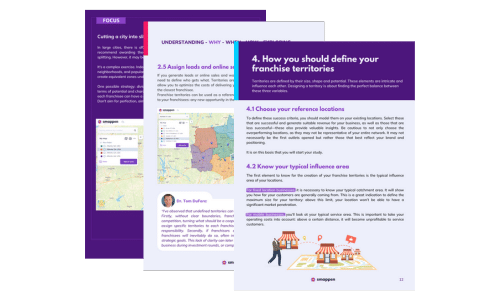FREE EBOOK Download
The Franchise Territory Design Guide

Whether you’re a budding entrepreneur or a seasoned franchisor, this guide is your roadmap to mastering the art of territory planning.
Download now and start sculpting your path to franchise excellence!
Download now
Contributors from the Franchise Family 🌟



In the report you’ll uncover
- Understanding what are territories
- 5 reasons why you should define franchise territories
- When you should define them
- Tutorial: How you should define them
- Additionnal tips to keep an eye on good opportunities

Download now
Start using smappen now
Read our best blog posts about franchising
Scaling Franchise Success with Simplicity: Body Street’s Story
Body Street BodyStreet is a German fitness franchise specializing in
Franchisee Recruitment – How to Maintain Long-Term Relationships with Franchisees: Expert Advice for Franchisors
Practical steps and expert advice on how to maintain strong relationships with your franchisees, driving success for all!
Franchisee Recruitment – Convincing franchisee candidates : Territory’s best selling points
A well-defined and data-driven franchise territory can be a make-or-break factor in convincing franchisee candidates to join your network.
How Dogdrop Maps Smart Growth with Smappen
Dogdrop Dogdrop is a unique dog daycare company aiming to
Kids United: Smarter Territory Planning, Stronger Franchises
Kids United Kids United is an early development soccer program
Franchisee Recruitment – How to attract franchisee candidates in 3 steps
Let’s dive into these steps so you can start building the perfect franchisee who’ll help grow your business.
What is Franchise Territory Design?
Franchise territory design is the organized process of structuring a franchised unit to maximize organizational resources to serve a specific geographic area. The goal of franchise territory design is to achieve the highest potential sales, profits, and market share in the franchisor’s current and future markets. It entails understanding the current and expected customer base and the competitive landscape of the area in order to map out an effective territory. With careful planning, a franchise can maximize its potential in the competitive market.
Why is Franchise Territory Design important?
Franchise territory design is a critical aspect of franchise business models for 7 main reasons:
Market Penetration and Coverage: Effective territory design ensures that franchises cover the market adequately, allowing for optimal market penetration without oversaturating any particular area. This helps in maximizing reach and minimizing internal competition.
Territorial Exclusivity: It provides franchisees with a sense of security and investment protection by guaranteeing territorial exclusivity. This means franchisees don’t have to worry about direct competition from the same brand within their designated area.
Efficient Resource Utilization: Well-designed territories enable franchisees to utilize their resources, including marketing and logistics, more efficiently. This is because they have a clear understanding of their operational area and target market.
Conflict Avoidance: By clearly defining territories, the franchisor can prevent conflicts between different franchisees. This is crucial for maintaining a harmonious network and avoiding disputes over customers or locations.
Enhanced Brand Consistency: A well-planned territory design helps in maintaining brand consistency across different locations. It ensures that all franchisees are operating under similar market conditions, which can lead to a more uniform brand experience for customers.
Strategic Growth and Expansion: Territory design plays a vital role in strategic planning for both franchisors and franchisees. It helps in identifying potential areas for expansion and growth, and in planning the scalability of the franchise.
Local Market Adaptation: Properly designed territories allow franchisees to adapt their strategies and offerings to local market conditions, preferences, and demographics, thus increasing the likelihood of success in their specific area.
The Challenges of Franchise Territory Design
In the intricate world of franchising, designing territories is a task that intertwines strategy with creativity. It’s a complex puzzle that challenges franchisors to not only carve out profitable and sustainable territories but also to navigate through a myriad of obstacles. This segment explores the nuances and hurdles in the process of franchise territory design, detailing the intricacies involved in setting parameters, developing plans, and facing the inevitable uncertainties of the market.
Setting Parameters
The first hurdle, Setting Parameters, involves critical decisions that lay the groundwork for franchise success. Parameters such as geographical boundaries, demographic considerations, and market saturation levels are crucial. For instance, a franchisor must decide how large each territory should be, taking into account factors like population density, urban versus rural settings, and the presence of similar businesses. Decisions about exclusivity rights and restrictions on franchisee operations within these territories also come into play, shaping the competitive landscape.
Developing Plans
When it comes to Developing Plans, franchisors face the task of crafting strategies that are not only robust but also flexible enough to adapt to market changes. This involves analyzing market trends, assessing consumer behavior, and forecasting future growth potential. Plans must include marketing strategies tailored to local demographics, logistical considerations for supply chain management, and growth strategies that align with both the franchisor’s vision and the franchisees’ capabilities.
Facing Uncertainty
Perhaps the most formidable challenge is Facing Uncertainty. The market is an unpredictable entity, affected by factors such as economic shifts, changing consumer preferences, and even regulatory changes. Franchisors must cultivate the ability to quickly adapt to these changes. This requires building contingency plans, staying abreast of market trends, and maintaining open communication channels with franchisees to ensure swift and coordinated responses to any market upheavals.
In summary, the process of franchise territory design is a complex and dynamic undertaking, filled with challenges that require strategic thinking, detailed planning, and the agility to adapt to an ever-evolving marketplace. This exploration aims to shed light on these challenges, providing a roadmap for navigating the intricate world of franchise territory design.
The Benefits of Franchise Territory Design
Efficient territory management for franchisors is not just a task, but a powerful tool that offers many benefits. Effective franchise territory design can be the linchpin in the machinery of a franchise’s success, offering increased efficiency, improved profitability, and enhanced brand recognition. Let’s delve into how each of these benefits plays a vital role in the overall health and growth of a franchise system.
Increased Efficiency
Firstly, Increased Efficiency is a hallmark of well-designed franchise territories. By clearly defining the operational areas for each franchisee, the design minimizes overlaps and conflicts, ensuring that resources are utilized optimally. This structured approach allows franchisees to focus their marketing and customer service efforts more effectively within their designated area, leading to streamlined operations and reduced waste of resources. It also facilitates better logistics and supply chain management, as territories are mapped out with practicality and accessibility in mind.
Improved Profitability
Then there’s the aspect of Improved Profitability, which is a direct offshoot of well-planned territory design. By ensuring that each franchise unit operates in an area with a sufficient target market and minimal direct competition from the same brand, each franchisee is positioned for maximum revenue generation. The exclusivity and strategic location of territories can lead to higher sales volumes and, in turn, greater profit margins. Additionally, a well-structured territory can help in identifying underserved markets, providing opportunities for expansion and growth.
Better Brand Recognition
Lastly, Better Brand Recognition is significantly bolstered through strategic territory design. Consistency in brand presence across different regions is maintained, as each franchisee serves a specific area with a standardized level of service and brand messaging. This uniformity in brand experience strengthens customer loyalty and enhances brand reputation, as customers across different territories receive a consistent brand message and quality of service. This widespread and consistent brand presence helps in building a stronger, more recognizable brand image in the marketplace.
In conclusion, the design of franchise territories is not just about dividing a map into segments; it’s about crafting a strategic foundation that supports efficient operations, drives profitability, and enhances brand recognition. These benefits collectively contribute to the robustness and success of the franchise system as a whole.
Tools for Franchise Territory Design
It is crucial to have the right tools when creating franchise territory maps and territory management. These tools not only simplify the process but also provide a depth of analysis and insight that can be pivotal for success. From map design software to sophisticated Geographic Information Systems (GIS), each tool plays a unique role in crafting effective franchise territories. Let’s explore some of these essential tools that are transforming the landscape of franchise territory design.
Mapping Software
Map Design Software is the artist’s palette in the world of franchise territory design. It allows franchisors to visually plot and design territories on a map. These software programs are user-friendly and offer a basic yet effective way to create, adjust, and visualize territories. They often include features like drawing tools, color-coding options, and the ability to import various map formats. This software is ideal for initial design phases, where broad strokes are needed to outline the franchise’s geographic strategy.
Territory Mapping Platforms
Territory Mapping Platforms take franchise territory design to a more advanced level. These platforms are specialized tools that enable franchisors to not only design but also manage and analyze franchise territories.
Franchise territory mapping software often include more sophisticated features like demographic data overlays, sales performance tracking, and integration with CRM systems. These platforms help in making data-driven decisions, allowing franchisors to align territories with market potential and business objectives.
>> Try out Smappen, your Franchise Mapping Software
Geographic Information Systems (GIS)
Geographic Information Systems (GIS) are the powerhouse tools in territory design. They offer a comprehensive suite of capabilities for analyzing geographical and demographic data. GIS can process and display large sets of data in a way that is insightful for strategic planning. They allow franchisors to delve into detailed analyses, like customer density, buying patterns, traffic flow, and competitor locations. GIS tools are invaluable for in-depth market analysis and for making informed decisions based on complex data sets.
In summary, these tools form the backbone of effective franchise territory design. Each offers unique features and capabilities, from basic mapping to in-depth market analysis, ensuring that franchisors can develop territories that are not only strategically sound but also aligned with market realities and business goals.
Examples of Franchise Territory Design
Franchise territory design varies significantly across different industries. Each type of franchise – be it a restaurant, retail, or service – has unique considerations and strategies when it comes to mapping out territories. Let’s dive into how territory design plays out in these varied sectors, illustrating the distinct approaches and considerations for each.
Restaurant Franchises
In the world of Restaurant Franchises, territory design is often about balancing high foot traffic with competition density. A key strategy is to ensure that each franchise is placed in an area with enough potential customers but not so close to another franchise of the same brand that they cannibalize each other’s sales. Factors like population density, local dining trends, and accessibility are crucial. For example, a fast-food franchise might thrive in a busy urban area with high foot traffic, while a fine-dining franchise may be more successful in affluent neighborhoods or areas with tourist attractions.
Retail Franchises
For Retail Franchises, territory design must consider factors like shopping patterns, demographic compatibility, and retail saturation. The focus is on placing franchises in locations where the target customer base shops and where the products offered fill a market gap. For instance, a clothing retail franchise might be strategically placed in shopping malls or fashion districts, while a home improvement retail franchise could be more successful in suburban areas where homeownership is high.
Service Franchises
Service Franchises, such as cleaning, home repair, or fitness services, require a different approach. Here, territory design focuses on covering residential or commercial areas effectively. It’s about ensuring that each franchise can serve a sufficient number of clients without overlapping with another franchise’s area. The demographic needs (such as income levels for luxury services) and the density of potential clients in an area are key considerations. For example, a home cleaning service franchise might focus on suburban areas with a high concentration of dual-income families, while a fitness franchise might target urban areas with a younger demographic.
